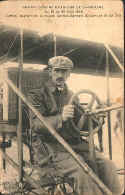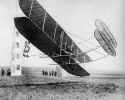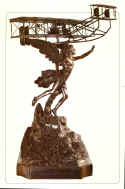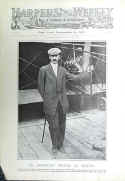|

 Up
Up 
 Rheims
Rheims 
(You are here.)



  Need
to Need
to
find your
bearings?
Try
these
navigation aids:
If
this is your first
visit, please stop by:
Something
to share?
Please:



|
|
Available in Française, Español, Português, Deutsch, Россию,
中文,
日本, and others.
 hen
the suit was filed, Curtiss was no longer in America. He was in France
with yet another new airplane, similar to the Golden Flyer but with
a shorter wingspan to cut down on the drag and a more powerful engine to
increase the speed. He called it the Rheims Racer. hen
the suit was filed, Curtiss was no longer in America. He was in France
with yet another new airplane, similar to the Golden Flyer but with
a shorter wingspan to cut down on the drag and a more powerful engine to
increase the speed. He called it the Rheims Racer.
The French had organized the first international aviation meet,
officially known as La Grande Semain d'Aviation de Champagne, in
the ancient cathedral city of Rheims. Twenty-two airmen from all over the
world attended, bringing with them 38 airplanes, 23 of which actually made
it into the air — an astounding display of airmanship. The planes
represented 10 different manufacturers. Most of the aircraft were French
— Voisons, Bleriots, Antoinettes, and Farmans. There were also 6
French-built Wright aircraft, although the Wright brothers themselves did
not attend. Curtiss and his Rheims Racer were the only American and
the only American-built airplane present.
It was a grand affair. The air meet was backed by the city of Rheims
and the neighboring vinters, who cleared Bethany Plain near the city and
built an "aeropolis." The ten-square kilometer flying field
boasted hangers, grandstands, barber shops, florists, and a 600-seat
terrace restaurant where spectators could sip champagne and listen the
fiddlers as they watched the air races. The aviators arrived like knights
and nobles with elaborate entourages, including ground crews, equipment,
and spare airplanes. Gabriel Voison brought an entire field kitchen and
the cooks to man it.
By contrast, Glenn Curtiss had two mechanics, a single airplane, and a
spare propeller. But the austerity and simplicity of his operation
endeared him to the French, perhaps because it remained them of the
simplicity of Wilbur Wright just a year ago. He quickly became one of the
favorites with the aviators, spectators, and newspapers.
The last was something of consternation to Curtiss. Before he left, he
had labored night and day to perfect a new 50-horsepower motor. He thought
of it as his edge, by which he might win the speed competition and capture
the Gordon Bennett Trophy, the most coveted and important award at Rheims.
But the newspaper soon spread the word of his marvelous engine, and Louis
Bleriot quickly had one of his airplanes fitted with an 80 hp motor.
"When I learned of this," said Curtiss, "I believed my
chances were very slim indeed, if in fact they had not entirely
disappeared."
One of his mechanics, however, bucked him up. "Glenn," said
Tod Shriver, recalling their old motorcycling days, "I've seen you
win many a race on the turns."
The air meet opened to bad weather on the morning of August 22. But by
late afternoon, the skies had cleared, the winds were still, and seven
airplanes took the skies together. It was an incredible spectacle that
awed everyone present, aviators and spectators alike. Curtiss, however,
held back. He avoided exposition flights and chose not to participate in
the endurance competition. He had only one plane and one motor, and he
could not risk them before the speed trials.
He did, however, make a number of short practice flights to get
familiar with his new airplane and make sure it was working properly. On
the second day of the meet, he took to the air and set an unofficial speed
record of 43 mph. His triumph was short lived, however. The next day
Bleriot topped him with 46 mph.
Curtiss and his mechanics began to tinker to see if they could coax a
bit more speed from their airplane. They removed the bulky gas tank and
replaced it with a slimmer one to reduce drag. They contemplated buying new
propellers to increase thrust and fussed over the engine, trying to coax
more power from it. Bleriot, too, was tinkering with his airplane. When a
minor accident necessitated repairs, he cut down the wings, making them
slimmer. This reduced his lift slightly, but it also reduced drag.
On the day of the Gordon Bennett cup race, Curtiss made his speed run
as early as he could. "I climb as high as I thought I might without
protest, before crossing the starting line — probably 500 feet — so
that I might take advantage of a gradual descent throughout the race, and
thus gain additional speed." Over the starting line Curtiss nosed
over slightly and began to pick up speed. "I cut the corner as close
as I dared and banked the machine high on the turn," he recalled. On
the backstretch, flying as fast as he could, he smashed into an invisible
wall of turbulence. "The shocks were so violent that I was lifted
completely out of my seat," said Curtiss. At this point, the prudent
thing to do was to power back to keep the machine from shaking to pieces.
But Curtiss powered through the thermals and reached smooth air again.
When he landed, a mob of cheering Americans rushed him. He had set a new
world's record — 46.5 mph.
Other aviators had yet to fly, however. As Curtiss watched "like a
prisoner awaiting the decision of the jury," one by one they flew and
fell short of his mark. There was no serious competition until it was
Bleriot's turn. On the first leg of the course, Bleriot's trimmed wings
seemed to be giving him the edge — his first circuit was four seconds
faster than Curtiss. But the winds had become gusty, and Bleriot had to
fight to maintain a true course. He landed to thundering applause from the
French and walked over to the judges booth. Curtiss remained a respectful
distance. The crowd was dead quiet and remained that way until suddenly
the silence was pieced by a shriek of joy. The shout came from Courtland
Bishop, president of the Aero Club of America, who was in the judges
stand. He came running over to Curtiss. "You win! You win!" he
shouted. Curtiss had beaten Bleriot by just six seconds.
The Gordon Bennett Trophy was his. Newspapers would dub Curtiss
"Champion Aviator of the World," and he would return to a hero's
welcome in New York. More importantly his fame — and the reputation of
his airplanes — now rivaled the Wright brothers.
|

The Rheims Racer in its final
form with shortened wings.

The cockpit of the Rheims Racer.

Glen Curtiss at the controls of the Rheims Racer.

A pylon race at Rheims.

Although the Wrights did not attend the Rheims Air Meet,
their airplanes competed. This Wright Model A was flown by LeFebre, the
chief test pilot for the Wright Company in France.

Curtiss over the grandstands in Rheims.

A worried Bleriot watches Curtiss' performance.

Close-up of Curtiss passing by the grandstands.

Curtiss' victory parade at Rheims.

The Gordon Bennett Trophy.

Curtiss' triumph was front page news in newspapers and
magazines across the United States.

The Rheims Racer went on display in Wannamaker's
department store in New York City after returning to America.
|